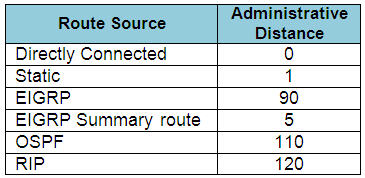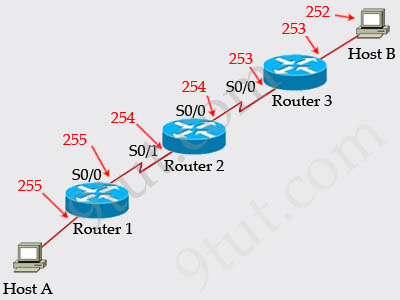CCNA – IP Routing Questions
Question 1
Explanation
The router considers the most reliable information about the path (the best route) based on Administrative Distance (AD). This is a good tutorial about AD: http://www.cisco.com/c/en/us/support/docs/ip/border-gateway-protocol-bgp/15986-admin-distance.html.
In general, the AD number defines the reliability of a routing protocol. A directly connected interface has an AD of 0 which is best so it is always chosen first.
Question 2
Question 3
Explanation
When one route is advertised by more than one routing protocol, the router will choose to use the routing protocol which has lowest Administrative Distance. The Administrative Distances of popular routing protocols are listed below:

Question 4
Question 5
Explanation
From the CCNA ICND2 Exam book: “Routers decrement the TTL by 1 every time they forward a packet; if a router decrements the TTL to 0, it throws away the packet. This prevents packets from rotating forever.” I want to make it clear that before the router forwards a packet, the TTL is still remain the same. For example in the topology above, pings to S0/1 and S0/0 of Router 2 have the same TTL.
The picture below shows TTL values for each interface of each router and for Host B. Notice that Host A initializes ICMP packet with a TTL of 255:

Question 6
Question 7
Explanation
In this question, Host1 wants to ping Host2 but it receives a reply from the interface Fa0/0 of Router1 (10.1.1.1/24) that the “destination host unreachable”.
If the link between Host1 and Switch1 is down or the link between Switch1 and Router1 is down then Host1 can not receive this reply -> A and F are not correct.
Host1 can receive a reply from 10.1.1.1 -> the TCP/IP is working properly -> B is not correct.
For answer D, if the default gateway was not configured correctly on Host1 (in this case the default gateway should be 10.1.1.1/24) then 10.1.1.1 can not receive the ping packets from Host1 and can not reply for Host1 that the destination is unreachable -> D is not correct.
Interface Fa0/0 on Router1 replies for the ping packets from Host1 so it is up -> E is not correct. If the interface Fa0/0 on Router is shutdown then we will receive a message of “Request timed out”, not “Destination host unreachable”.
Answer C is correct because we can get a reply from the interface Fa0/0 of Router1 so the link between Host1 and Router1 should be fine -> the problem lies at the other side of Router1. But if the link between Router2 and Host2 is down then we will receive a reply from interface S0/1 of Router2 that the “destination host unreachable”. Therefore the problem can just be the link between Router1 and Router2.
Question 8
Question 9
Explanation
The simple syntax of static route:
ip route destination-network-address subnet-mask {next-hop-IP-address | exit-interface}
+ destination-network-address: destination network address of the remote network
+ subnet mask: subnet mask of the destination network
+ next-hop-IP-address: the IP address of the receiving interface on the next-hop router
+ exit-interface: the local interface of this router where the packets will go out
In the statement “ip route 10.5.6.0 255.255.255.0 fa0/0″:
+ 10.5.6.0 255.255.255.0: the destination network
+ fa0/0: the exit-interface


